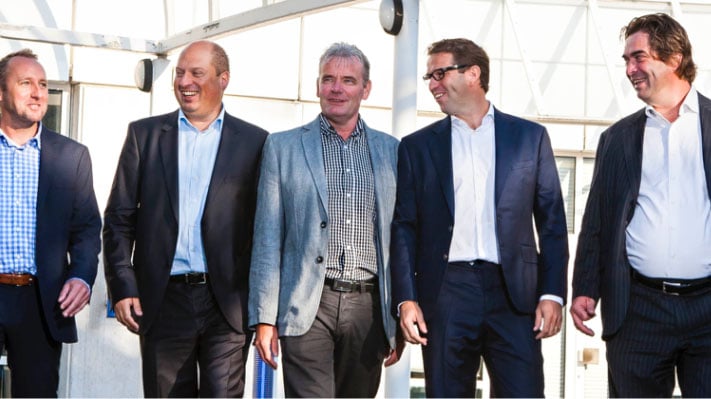Arlanxeo was founded as a joint venture between LANXESS and Saudi Aramco in 2016. Until then, the synthetic rubber production was a part of LANXESS and had been using the reporting & consolidation tools of the mother company. “When the joint venture was founded, we knew that we had to build our own group functions,” says Manfred Wicker, Head of Finance & Controlling Platforms at Arlanxeo, about the reasons for implementing SAP BPC Optimized for HANA.
Even though the company is relatively young, it is rooted in a long history: the patent on the production of synthetic rubber stems from 1909. Today, the company has plants in nine countries and specializes in high performance rubbers. Employing approximately 3,900 people worldwide, the corporate headquarters are in Maastricht, Netherlands.
"Building and maintaining the interface between ERP and the consolidation system was time consuming and expensive. Therefore, we wanted to significantly simplify the interface in the new situation."
Setting up a completely new IT architecture
Building the complete architecture from scratch was a great opportunity to create a smooth consolidation process. “At LANXESS, we had some issues with the interface between ERP and the consolidation system. To build and maintain this interface was time consuming and expensive. Therefore, we wanted to significantly simplify the interface in the new situation,” explains Manfred.
To get the most out of the new set-up, the company took a critical look at the current processes as well. “We built a new group chart of account, which aligns with the transactional chart of accounts. Also, we’ve started to use the same reporting pack for both actuals and planning. This is more efficient, but also makes it easier for users to compare the two reports,” says Ingrid Fredrix, Head of Financial Accounting and Consolidation at Arlanxeo.
First implementation of SAP BPC Optimized for HANA in Europe
The company had already chosen S/4HANA and looked for an SAP consolidation system as well. “After discussing the various BPC options, SAP recommended us to use SAP BPC Optimized for HANA,” says Manfred. Choosing this new technology makes the company a front runner: it is the first implementation of SAP BPC Optimized for HANA in Europe and one of the first worldwide.
Implementing a new technology requires a lot of attention to detail. “We wanted to make sure all processes were correct, maintainable and user friendly. In the classic SAP BPC, for instance, building input schedules was simple, but in the BPC Optimized version we needed to find a way to make it more user friendly,” says Bastiaan Sanders, as lead consultant at Plainwater closely involved in the architecture and implementation of the new system.
Adjusting to major changes by using an Agile project approach
To ensure effective decision-making, the chosen project approach was Agile based. “As we were building an entirely new IT landscape, we did not have a full picture of the details yet. Also, as SAP BPC Optimized was so new, it was not quite clear which possibilities it would bring us,” says Ingrid.
During the project two additional challenges arose. First of all, the ownership of the company changed to being 100% owned by Saudi Aramco. This shortened the timelines of the implementation by three months. Secondly, during the implementation the server was moved from on-premise to the private cloud of SAP; the HANA Enterprise Cloud.
Despite these challenges, the new consolidation system was up and running within a few months. “The Agile approach helped us to adjust to all these changes much easier. If we would have used a waterfall method, such major changes would not have been possible, or at least it would have taken longer,” Ingrid explains.
Team of specialists from four sister companies
In the project team, experts of Plainwater, Finext, Tribers and Swap Support joined forces. The four sister companies often work together during Performance Management implementations. As Bastiaan puts it: “Plainwater has in-depth knowledge of SAP HANA, BPC, and data-integration, whereas Finext combines financial and technical expertise. Together, we look at both functional and technical requirements. Tribers specializes in the Agile project approach, and Swap Support takes care of support for SAP EPM.”
Combining these specialists has great advantages, says Ingrid: “From a team perspective, it is one team; the only difference is their email address. You can ask one person, and he will follow it up with the others to find the best solution. Whether it’s technical, financial or support, you can be confident it’s always coming together. This enabled us to build as efficient and straight-forward as possible, without too many customizations. Also, after the go-live the connection between the implementation team and the support team continues, which makes it easier if questions arise in the future.”
"Now, we can answer all questions from one source. This makes the day-to-day work in the accounting area much easier."
Faster and more flexible consolidation
Both Manfred and Ingrid are enthusiastic about the results of the new landscape: “We were able to simplify the processes and to use more standard functionality. This makes the consolidation faster and gives us more flexibility to change things,” explains Manfred. “Once all entities are fully on S/4HANA, I expect the close to be 2-3 days faster,” agrees Ingrid.
Another benefit is going from three different profit and loss (p&l) reports to one. “In the old set up, we had different p&l reports for legal, management and accounting purposes. Now, we can answer all questions from one source. This makes the day-to-day work in the accounting area much easier.”
Direct access to real-time data
Also, direct access to the data provides real-time insights. “We can use the data real-time for the consolidation, by accessing the data directly without the need for an interface or mapping tables. Previously, we extracted data from the ERP system into the consolidation system once a day, now as often as we’d like to,” says Manfred.
The next step is a fast-close project, with the aim to go from 10 to 6 days. “We need to accelerate our closing for Saudi Aramco,” says Manfred. “First, we need to standardize the closing steps in the ERP part, then we want to automate the steps in the closing postings. We’re looking at various RPA solutions as well, for instance to robotize the incoming invoices.”
Use the opportunity to make a radical change
When asked to give advice to other organizations who want to implement a new IT environment, Ingrid says: “Use the opportunity to make a radical change. There are real advantages in uniformizing, which will save time and effort in the end product. Even if you’re only changing your ERP or consolidation system, looking at both systems will take the total process to a higher level.”
“Focus on the S of simplifying,” concludes Manfred. “It is really beneficial to follow the ideas of simplification by using the standard processes in SAP S/4HANA as much as possible. This may not be easy in the beginning but will be much easier in the future than customizing the tool to the process you currently have.”
Share this
You may also like
These related stories

Strong cooperation in Proof of Concept SAP SAC at ASML

Finance and IT join forces at Wavin using SAP BPC

